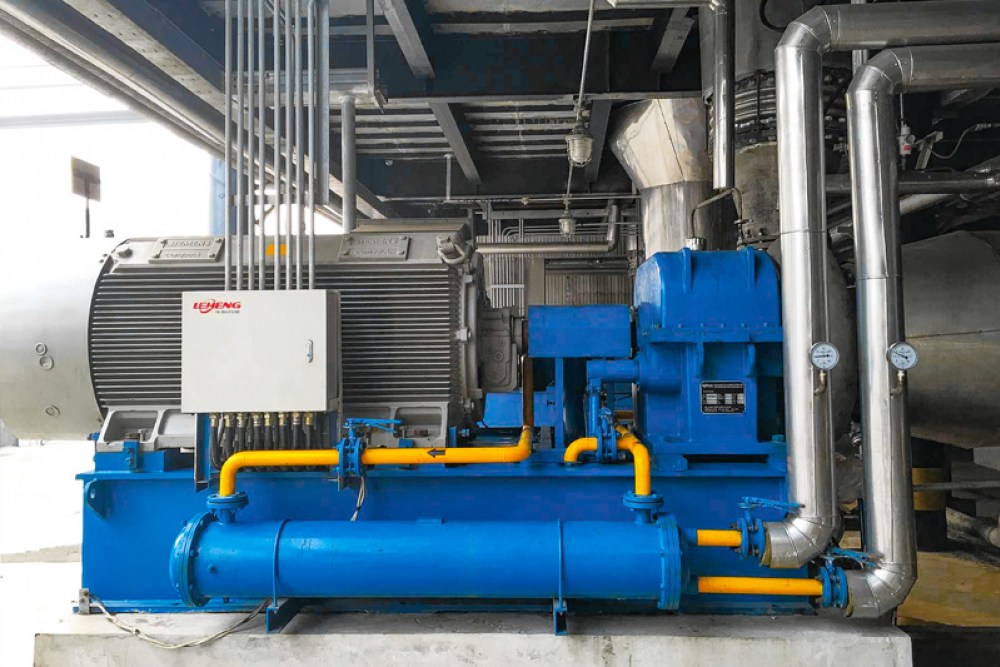(قسمت 5/6)++++

در بخش کریستالایزر که عموما از ترکیب یک یا چند بدنه تبخیر کننده و مبدل حرارتی استفاده می شود، با توجه به انرژی که به پساب از طریق بخار (یا هوای داغ و یا گازهای حاصل از احتراق) داده می شود، باعث بالا رفتن دمای پساب شده و نرخ تبخیر زیاد شده و پساب رفته رفته از وضعیت غیر اشباع، به حالت اشباع و بعد از آن به حالت فوق اشباع می رسد و در این شرایط در مبدل با کاهش جزئی دما، بخشی از املاح محلول به حالت جامد تبدیل شده با تجهیزاتی از قبیل سانتریفیوژ مواد جامد جدا شده و از طرف دیگر بخار (اشباع یا فوق داغ) بعد از تبادل انرژی با خوراک (به دلیل بهینه سازی مصرف انرژی) به سمت مصرف کننده و یا ذخیره سازی آب ارسال می گردد. این آب، کیفیت آب مقطر را داشته و بخشی از آن می تواند دوباره در همین واحد استفاده شود.
با توجه به توضیحات داده شده هرچه خوراک ورودی به کریستالیزر به حالت اشباع نزدیک تر باشد (TDS بالاتری داشته باشد) میزان مصرف انرژی کاهش می یابد.


تبلور عبارت است از تولید یک جامد (کریستال یا رسوب) از یک مایع همگن که به سطح اشباع (غلظت> حلالیت) در آن درجه حرارت تغلیظ می شود.
فرآیند تبلور سه مورد زیر را شامل می شود:
• اشباع کردن محلول همراه با خنک کردن همراه با تبخیر جزیی
• اشباع کردن از طریق تبخیر حلال همراه با کمی خنک کردن
• تبخیر با ترکیبی از خنک کننده و تبخیر در تبخیر کننده های آدیاباتیک (تبلورهای خلاء)


Crystallization (ZLD)
Crystallization is the production of a solid (crystal or precipitate) formed from a homogeneous, liquid which is concentrated to supersaturation levels (concentration > solubility) at that temperature.
The available crystallization processes are the following three,
- Supersaturation by cooling the solution with trivial evaporation
- Supersaturation by evaporation of the solvent with little cooling
- Evaporation by a combination of cooling and evaporation in adiabatic evaporators (vacuum crystallizers)
Crystallizers can put up with the continuous crystallization of all sparingly and highly soluble sodium salts such as sodium chloride and sodium sulfate, without excessive scaling and cleaning frequencies. This means higher specific energy consumption (OPEX) and higher specific capital cost (CAPEX).
They normally use live steam but can also use MVR (forced circulation) technology to recycle the vapor in order to reduce the energy consumption and thus the OPEX. Forced circulation crystallizers concentrate brine blowdown from upstream concentration equipment, although small wastewater flows are sometimes treated directly with a forced circulation crystallizer. The solid by-products give the option of recovering the valuable salts at the end of the ZLD process.
- Process Explanation
Crystallization occurs in the forced-circulation evaporator-crystallizer, where we have the generation and augmentation of the crystals within the bulk solution (Fig.1). The evaporator/crystallizer scheme is followed by a dewatering device (centrifuge or pressure filter), which separates the salt crystals from the product slurry. The mother liquor is returned to the crystallizer for further concentration.

Fig.7, Crystallizer process.
The forced-circulation evaporator is normally fed by an external source of steam heating which is used due to the high boiling point rise (BPR) of the solution at high concentration. The crystallizer needs ca. a bit more than 1 ton of steam to evaporate 1 ton of water.
- Highly Soluble Salts and Evaporator BPR
Using a falling film evaporator for brine volume minimization we are able to remove 75% to 95% of the water. In the presence of highly soluble salts in the feed stream, the last 5% to 25% of water is difficult to evaporate.
When the ion concentration of the salts increases, the boiling temperature of the solution increases as well. The increase in boiling temperature of a solution above that of water at a given pressure is called the BPR.
Let’s take for example calcium chloride (CaCl2) which is the main dissolved salt in wet limestone FGD blowdown. Figure 2 shows the increase of the boiling point temperature as the concentration of calcium chloride increases in the solution. The two curves intersect at the solubility limit of calcium chloride in a boiling solution. Calcium chloride is very soluble in water; as a solution is concentrated by evaporation at 1 atmosphere (atm), its boiling point continues to rise, until the solubility limit of about 75% by weight is reached and calcium chloride dihydrate (CaCl2.2H2O) crystallizes out from the solution. Figure 2 further shows that a saturated solution of calcium chloride at a pressure of 1 atm has a boiling temperature of almost 176.6 oC (350F), a BPR of 58.8 oC (138F).

Fig.2, Graphical representation of the relationship between the boiling temperature for pure calcium chloride solution against its solubility curve at atmospheric pressure. As the weight percentage of the calcium chloride increases in solution, so does the boiling point of the solution.
At this high temperature, calcium chloride, like magnesium chloride (MgCl2) and ammonium chloride (NH4Cl), sustains hydrolysis in water which means that it releases hydrochloric acid which will aggressively attack steel. The higher the temperature, the higher the rate of hydrolysis, so evaporator vessels and heat transfer surface need construction materials will be able to resist the extremely corrosive nature of these salts at high concentrations and temperatures. These are very expensive noble alloys, such as palladium-alloyed titanium and high nickel-chrome-molybdenum alloys which skyrocket the CAPEX and constitute the use of a crystallizer economically challenging in most of the ZLD applications.
